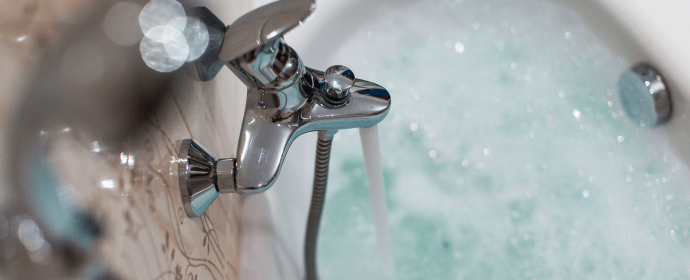Have you ever experienced the disappointment of turning on the tap, anticipating a refreshing water flow, only to be met with an unexpected fizziness? Indeed, the presence of foamy water can be quite perplexing, as if your faucet has unexpectedly transformed into a bubbling spectacle. And let’s be honest, it’s not exactly the type of enthusiasm we desire (unless you’re a dedicated bath bomb enthusiast).
When it comes to water, seeing foam can be unusual, but it doesn’t necessarily mean there’s something to worry about. Understanding the cause behind this phenomenon can help you in eliminating carbonation and returning your water to its pristine clarity. So, stay tuned whether you’re a homeowner looking for answers, a gardener with a foamy fountain, or a fish tank owner dealing with sudsy water.
Are you ready to understand why is my water foamy and get your water moving normally again? Sure, let’s get started!
Top 5 Reasons for Foamy Water
-
Excessive Air Bubbles:
Sometimes, it’s simply air! Fluctuations in water pressure can cause air to become trapped in pipes, forming temporary foam. Allow the tap to run for a brief period. The bubbles will dissipate, indicating that the water is ready for use. If there is persistent foaming, it could be due to a leaky faucet or the presence of trapped air pockets. If the problem persists, contacting a professional plumber might be a good idea.
-
Soap Scum Shenanigans:
Even a small trace of soap residue can lead to significant foaming, particularly in stagnant water. Reduce the amount of soap you use and rinse thoroughly to minimize the formation of suds. Using eco-friendly alternatives, such as castile soap, can be beneficial in reducing the accumulation of chemicals.
-
Mineral Mischief:
Iron and manganese minerals present in water can react with oxygen and form foam. Conduct a water analysis if you reside in a region renowned for its elevated mineral content. Based on the findings, a water softener or iron filter could be the solution you’re looking for.
-
Organic matter overload:
Foam can sometimes develop in ponds, fountains, and fish tanks due to the decomposition of leaves, food remnants, or other organic substances. Implementing regular cleaning, ensuring proper filtration, and utilizing biological water treatments are essential for maintaining a healthy aquatic environment.
-
Contamination concerns:
Occasionally, specific harmful contaminants can lead to foam formation. If you have concerns about potential contamination, it is crucial to take immediate action! It is advisable to contact your local water provider or authorities for further investigation and possible remediation. Always prioritize safety above all else!
Troubleshooting Tips
- Identifying the specific cause is crucial to determine the appropriate solution.
- Run the tap to release any trapped air, except ponds and tanks.
- Reduce the amount of soap or detergent used in still water.
- Explore options for testing and treating water with elevated mineral levels.
- Regularly cleaning ponds and tanks, maintaining filtration systems, and utilizing biological treatments are essential for optimal water quality.
- If you have any doubts or suspect that there may be contamination, it is advisable to consult with a professional for assistance.
Is it safe to drink foamy water? 
Just a moment! Before you take a drink, let’s take a moment to reflect. Be cautious when dealing with foamy water, as it may not always be safe. In most cases, minor air bubbles or traces of soap residue pose no significant harm. However, if the foam is persistent, discolored, or has an unusual odour, it is advisable to avoid consuming it and consult a professional for guidance. There may be a possibility of contamination, particularly in healthy water.
What is the significance of water that appears foamy?
When water appears foamy, it indicates the presence of trapped air, resulting in the formation of bubbles. However, the source of the air pollution can differ. Several factors could contribute to the presence of unpleasant odors in your water. These include trapped air in your pipes, residual soap, minerals in the water, and the breakdown of organic matter in ponds and tanks.
How do I stop foaming in water? 
The solution varies depending on the underlying cause. To address trapped air, running the water for a minute or two is recommended. To effectively remove soap scum, it is important to reduce the amount of suds and ensure thorough rinsing. Exploring water testing and treatment options for water with high mineral content is essential. Regular cleaning, filtration, and biological treatments are necessary to maintain the health of ponds and tanks. If you suspect contamination, seeking assistance from a qualified professional is essential.
Why is my water white and foamy?
White foam is often a result of air bubbles or soap residue. If the issue persists, inspecting for any potential leaks or the presence of high mineral content would be advisable. Remember that white foam may not be harmful, but it’s always a good idea to investigate the cause to put your mind at ease.
Is soft water foamy?
Soft water does not contribute to the formation of foam. However, if your softener utilizes soap-based beads for regeneration, it could lead to temporary foaming. Make sure to review the settings on your softener or reach out to the manufacturer for assistance.
How do you treat soapy water?
When it comes to washing dishes, it’s best to use a smaller amount of soap and make sure to rinse them thoroughly. Regular water changes and biological clarifiers can effectively break down soap residue in ponds or tanks.
Does salt make water foamy?
Minimal quantities of salt should not result in noticeable foaming. When saltwater is highly concentrated, such as in aquariums, it can trap air and form bubbles because of its heightened surface tension.
Keep in mind that the presence of foamy water may not always be a cause for concern.
However, it is essential to determine its source to address the issue promptly and efficiently. Understanding the reason behind the problems like trapped air, soap scum, or mineral buildup can give you the knowledge you need to address them effectively.



Leave a Reply